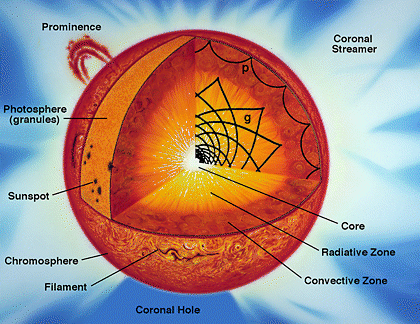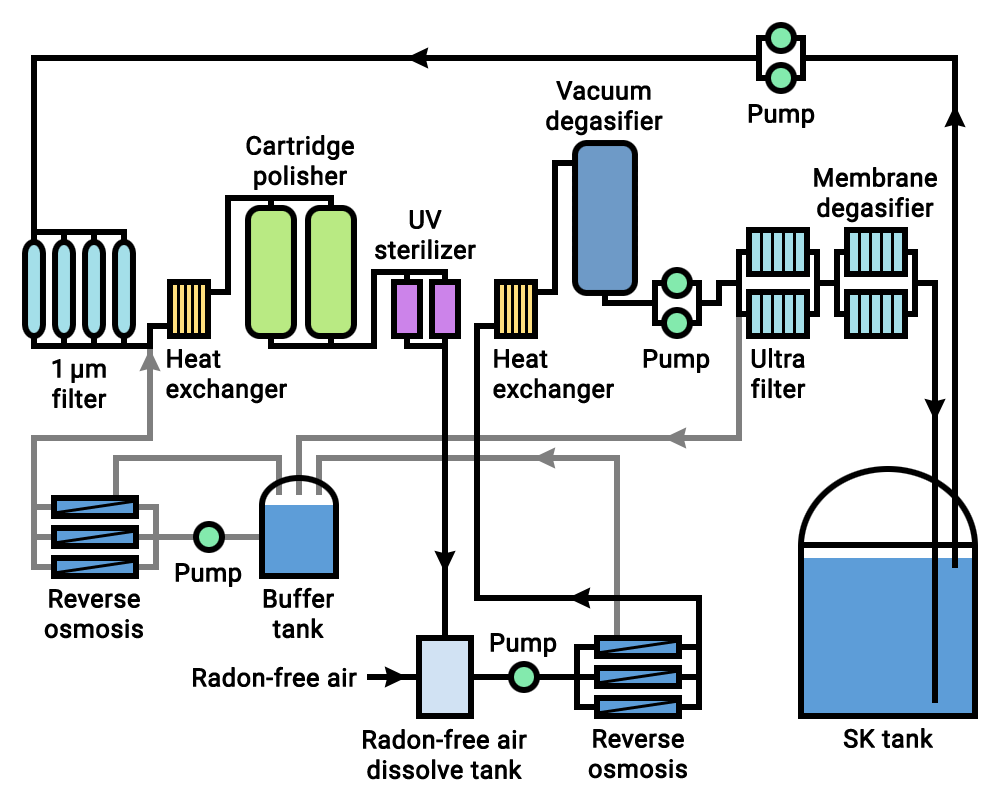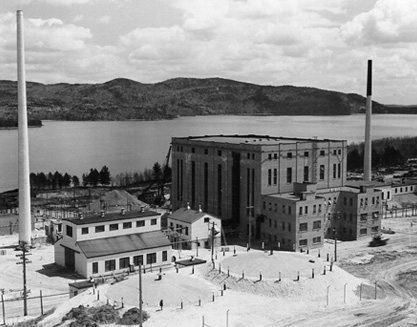|
Solar Neutrinos
A solar neutrino is a neutrino originating from nuclear fusion in the Sun's core, and is the most common type of neutrino passing through any source observed on Earth at any particular moment. Neutrinos are elementary particles with extremely small rest mass and a neutral electric charge. They only interact with matter via the weak interaction and gravity, making their detection very difficult. This has led to the now-resolved solar neutrino problem. Much is now known about solar neutrinos, but the research in this field is ongoing. History and background Homestake experiment The timeline of solar neutrinos and their discovery dates back to the 1960s, beginning with the two astrophysicists John N. Bahcall and Raymond Davis Jr. The experiment, known as the Homestake experiment, named after the town in which it was conducted (Homestake, South Dakota), aimed to count the solar neutrinos arriving at Earth. Bahcall, using a solar model he developed, came to the conclusion that ... [...More Info...] [...Related Items...] OR: [Wikipedia] [Google] [Baidu] |
Carbon
Carbon () is a chemical element with the symbol C and atomic number 6. It is nonmetallic and tetravalent In chemistry, the valence (US spelling) or valency (British spelling) of an element is the measure of its combining capacity with other atoms when it forms chemical compounds or molecules. Description The combining capacity, or affinity of an ...—its atom making four electrons available to form covalent bond, covalent chemical bonds. It belongs to group 14 of the periodic table. Carbon makes up only about 0.025 percent of Earth's crust. Three Isotopes of carbon, isotopes occur naturally, Carbon-12, C and Carbon-13, C being stable, while Carbon-14, C is a radionuclide, decaying with a half-life of about 5,730 years. Carbon is one of the Timeline of chemical element discoveries#Ancient discoveries, few elements known since antiquity. Carbon is the 15th Abundance of elements in Earth's crust, most abundant element in the Earth's crust, and the Abundance of the c ... [...More Info...] [...Related Items...] OR: [Wikipedia] [Google] [Baidu] |
Laboratori Nazionali Del Gran Sasso
Laboratori Nazionali del Gran Sasso (LNGS) is the largest underground research center in the world. Situated below Gran Sasso mountain in Italy, it is well known for particle physics research by the INFN. In addition to a surface portion of the laboratory, there are extensive underground facilities beneath the mountain. The nearest towns are L'Aquila and Teramo. The facility is located about 120 km from Rome. The primary mission of the laboratory is to host experiments that require a low background environment in the fields of astroparticle physics and nuclear astrophysics and other disciplines that can profit of its characteristics and of its infrastructures. The LNGS is, like the three other European underground astroparticle laboratories (Laboratoire Souterrain de Modane, Laboratorio subterráneo de Canfranc, and Boulby Underground Laboratory), a member of the coordinating group ILIAS. Facilities The laboratory consists of a surface facility, located within the Gran ... [...More Info...] [...Related Items...] OR: [Wikipedia] [Google] [Baidu] |
Canada
Canada is a country in North America. Its ten provinces and three territories extend from the Atlantic Ocean to the Pacific Ocean and northward into the Arctic Ocean, covering over , making it the world's second-largest country by total area. Its southern and western border with the United States, stretching , is the world's longest binational land border. Canada's capital is Ottawa, and its three largest metropolitan areas are Toronto, Montreal, and Vancouver. Indigenous peoples have continuously inhabited what is now Canada for thousands of years. Beginning in the 16th century, British and French expeditions explored and later settled along the Atlantic coast. As a consequence of various armed conflicts, France ceded nearly all of its colonies in North America in 1763. In 1867, with the union of three British North American colonies through Confederation, Canada was formed as a federal dominion of four provinces. This began an accretion of provinces an ... [...More Info...] [...Related Items...] OR: [Wikipedia] [Google] [Baidu] |
Greater Sudbury
Sudbury, officially the City of Greater Sudbury is the largest city in Northern Ontario by population, with a population of 166,004 at the 2021 Canadian Census. By land area, it is the largest in Ontario and the List of the largest cities and towns in Canada by area, fifth largest in Canada. It is administratively a List of census divisions of Ontario#Single-tier municipalities, single-tier municipality and thus is not part of any district, county, or regional municipality. The City of Greater Sudbury is separate from, but entirely surrounded by the Sudbury District. The city is also referred to as "Grand Sudbury" among Franco-Ontarian, Francophones. The Sudbury region was inhabited by the Ojibwe people of the Algonquin people, Algonquin group for thousands of years prior to the founding of Sudbury after the discovery of nickel ore in 1883 during the construction of the transcontinental railway. Greater Sudbury was formed in 2001 by merging the cities and towns of the former Regi ... [...More Info...] [...Related Items...] OR: [Wikipedia] [Google] [Baidu] |
Japan
Japan ( ja, 日本, or , and formally , ''Nihonkoku'') is an island country in East Asia. It is situated in the northwest Pacific Ocean, and is bordered on the west by the Sea of Japan, while extending from the Sea of Okhotsk in the north toward the East China Sea, Philippine Sea, and Taiwan in the south. Japan is a part of the Ring of Fire, and spans Japanese archipelago, an archipelago of List of islands of Japan, 6852 islands covering ; the five main islands are Hokkaido, Honshu (the "mainland"), Shikoku, Kyushu, and Okinawa Island, Okinawa. Tokyo is the Capital of Japan, nation's capital and largest city, followed by Yokohama, Osaka, Nagoya, Sapporo, Fukuoka, Kobe, and Kyoto. Japan is the List of countries and dependencies by population, eleventh most populous country in the world, as well as one of the List of countries and dependencies by population density, most densely populated and Urbanization by country, urbanized. About three-fourths of Geography of Japan, the c ... [...More Info...] [...Related Items...] OR: [Wikipedia] [Google] [Baidu] |
Cerenkov Detector
A Cherenkov detector (pronunciation: /tʃɛrɛnˈkɔv/; Russian: Черенко́в) is a particle detector using the speed threshold for light production, the speed-dependent light output or the speed-dependent light direction of Cherenkov radiation. Fundamental A particle passing through a material at a velocity greater than that at which light can travel through the material emits light. This is similar to the production of a sonic boom when an airplane is traveling through the air faster than sound waves can move through the air. The direction this light is emitted is on a cone with angle θc about the direction in which the particle is moving, with cos(θc) = (c = the vacuum speed of light, n = the refractive index of the medium, and v is the speed of the particle). The angle of the cone θc thus is a direct measure of the particle's speed. The Frank–Tamm formula = sin2θc gives the number of photons produced. Aspects Most Cherenkov detectors aim a ... [...More Info...] [...Related Items...] OR: [Wikipedia] [Google] [Baidu] |
Super-Kamiokande
Super-Kamiokande (abbreviation of Super-Kamioka Neutrino Detection Experiment, also abbreviated to Super-K or SK; ja, スーパーカミオカンデ) is a neutrino observatory located under Mount Ikeno near the city of Hida, Gifu Prefecture, Japan. It is located underground in the Mozumi Mine in Hida's Kamioka area. The observatory was designed to detect high-energy neutrinos, to search for proton decay, study solar and atmospheric neutrinos, and keep watch for supernovae in the Milky Way Galaxy. It consists of a cylindrical stainless steel tank about in height and diameter holding 50,000 metric tons (55,000 US tons) of ultrapure water. Mounted on an inside superstructure are about 13,000 photomultiplier tubes that detect light from Cherenkov radiation. A neutrino interaction with the electrons or nuclei of water can produce an electron or positron that moves faster than the speed of light in water, which is slower than the speed of light in a vacuum. This creates a ... [...More Info...] [...Related Items...] OR: [Wikipedia] [Google] [Baidu] |
Sudbury Neutrino Observatory
The Sudbury Neutrino Observatory (SNO) was a neutrino observatory located 2100 m underground in Vale's Creighton Mine in Sudbury, Ontario, Canada. The detector was designed to detect solar neutrinos through their interactions with a large tank of heavy water. The detector was turned on in May 1999, and was turned off on 28 November 2006. The SNO collaboration was active for several years after that analyzing the data taken. The director of the experiment, Art McDonald, was co-awarded the Nobel Prize in Physics in 2015 for the experiment's contribution to the discovery of neutrino oscillation. The underground laboratory has been enlarged into a permanent facility and now operates multiple experiments as SNOLAB. The SNO equipment itself was being refurbished for use in the SNO+ experiment. Experimental motivation The first measurements of the number of solar neutrinos reaching the Earth were taken in the 1960s, and all experiments prior to SNO observed a third to a ha ... [...More Info...] [...Related Items...] OR: [Wikipedia] [Google] [Baidu] |
Bruno Pontecorvo
Bruno Pontecorvo (; russian: Бру́но Макси́мович Понтеко́рво, ''Bruno Maksimovich Pontecorvo''; 22 August 1913 – 24 September 1993) was an Italian and Soviet nuclear physicist, an early assistant of Enrico Fermi and the author of numerous studies in high energy physics, especially on neutrinos. A convinced communist, he defected to the Soviet Union in 1950, where he continued his research on the decay of the muon and on neutrinos. The prestigious Pontecorvo Prize was instituted in his memory in 1995. The fourth of eight children of a wealthy Jewish-Italian family, Pontecorvo studied physics at the University of Rome ''La Sapienza'', under Fermi, becoming the youngest of his Via Panisperna boys. In 1934 he participated in Fermi's famous experiment showing the properties of slow neutrons that led the way to the discovery of nuclear fission. He moved to Paris in 1934, where he conducted research under Irène and Frédéric Joliot-Curie. Influence ... [...More Info...] [...Related Items...] OR: [Wikipedia] [Google] [Baidu] |



